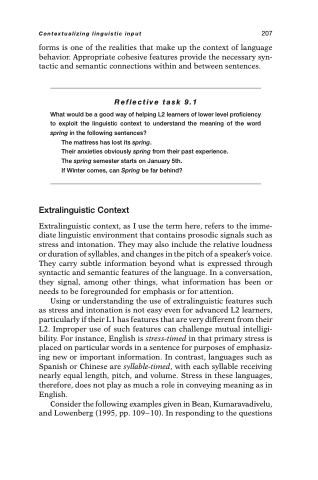Page 219 - Beyond Methods
P. 219
Contextualizing linguistic input 207
forms is one of the realities that make up the context of language behavior. Appropriate cohesive features provide the necessary syn- tactic and semantic connections within and between sentences.
Reflective task 9.1
What would be a good way of helping L2 learners of lower level proficiency to exploit the linguistic context to understand the meaning of the word spring in the following sentences?
The mattress has lost its spring.
Their anxieties obviously spring from their past experience. The spring semester starts on January 5th.
If Winter comes, can Spring be far behind?
Extralinguistic Context
Extralinguistic context, as I use the term here, refers to the imme- diate linguistic environment that contains prosodic signals such as stress and intonation. They may also include the relative loudness or duration of syllables, and changes in the pitch of a speaker’s voice. They carry subtle information beyond what is expressed through syntactic and semantic features of the language. In a conversation, they signal, among other things, what information has been or needs to be foregrounded for emphasis or for attention.
Using or understanding the use of extralinguistic features such as stress and intonation is not easy even for advanced L2 learners, particularly if their L1 has features that are very different from their L2. Improper use of such features can challenge mutual intelligi- bility. For instance, English is stress-timed in that primary stress is placed on particular words in a sentence for purposes of emphasiz- ing new or important information. In contrast, languages such as Spanish or Chinese are syllable-timed, with each syllable receiving nearly equal length, pitch, and volume. Stress in these languages, therefore, does not play as much a role in conveying meaning as in English.
Consider the following examples given in Bean, Kumaravadivelu, and Lowenberg (1995, pp. 109–10). In responding to the questions


